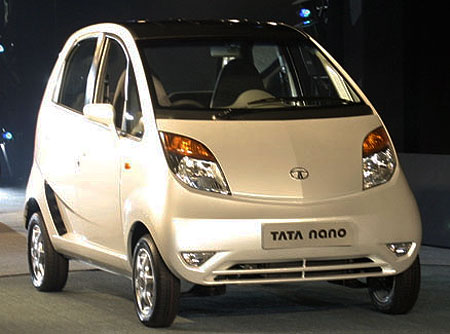
Tata has unveiled its 1-Lakh Car at the 2008 Delhi Motor Show, and its officially been christened the Tata Nano. The model at the motor show was powered by a 33 horsepower 624cc two-cylinder gasoline engine mated to either a stepless CVT transmission or 4-speed manual transmission. A diesel version will soon follow. The car will initially available with the manual, with the CVT to be available later.
The 4-seater (5 if you squeeze) Tata Nano uses 5 litres of fuel per 100km and meets all Indian local crash test and emissions guidelines. It was also designed to pass international side offset and side crash tests as well as Euro 4 emissions tests. It has a length of 3.1 metres, width of 1.5 metres and height of 1.6 metres
The two-cylinder engine, which uses Bosch’s Value Motronic fuel injection and engine management is mounted at the rear of the car together with the battery. There is a small boot at the front where a person would normally expect the engine bay to be.
The car has no power steering, but being so light I don’t think you’d really need one anyway, plus at its 1 Lakh price point you really can’t complain. It also lacks an RPM meter, with its instrument panel consisting of only a speedometer, a fuel gauge and an oil light. The car will be priced at 100,000 Indian rupees, or 1 Lakh, but customers will pay slightly more than 1 Lakh at the dealers because of taxes and other charges.
This 1 Lakh price tag is for the standard car, which does not have air conditioning. The two deluxe models will cost more. 1 Lakh Indian Rupees is roughly RM8,350.
Tata expects to sell 500,000 units of the Tata Nano, and the car will go on sale in the second half of 2008.
Previous Posts on the Tata 1-Lakh Car:
Tata 1-Lakh car to use Bosch Value Motronic ECU
Artist’s Impression: Tata Abarth 1-Lakh Car
More details on the Tata 1-Lakh Car
Tata set to launch US$2,500 car in mid-2008
Looking to sell your car? Sell it with Carro.


AI-generated Summary ✨
Comments express mixed reactions to the Tata Nano, highlighting its affordability and potential for low-income markets, especially in India, where it aims to provide transportation for families riding motorcycles. Some see it as a safer alternative to motorcycles, while others doubt its safety features and stability. Many discuss its low price as a major advantage, with some suggesting it could impact Malaysian markets and challenge existing small cars like the Kancil. Critics mention concerns about safety, lack of features like air conditioning, and the car's size—comparable to a motorcycle or smaller. Others praise the car's design for meeting crash tests and emissions standards, emphasizing its role in helping the poor. Overall, sentiments are a mix of admiration for its economic benefits and skepticism about safety and practicality.